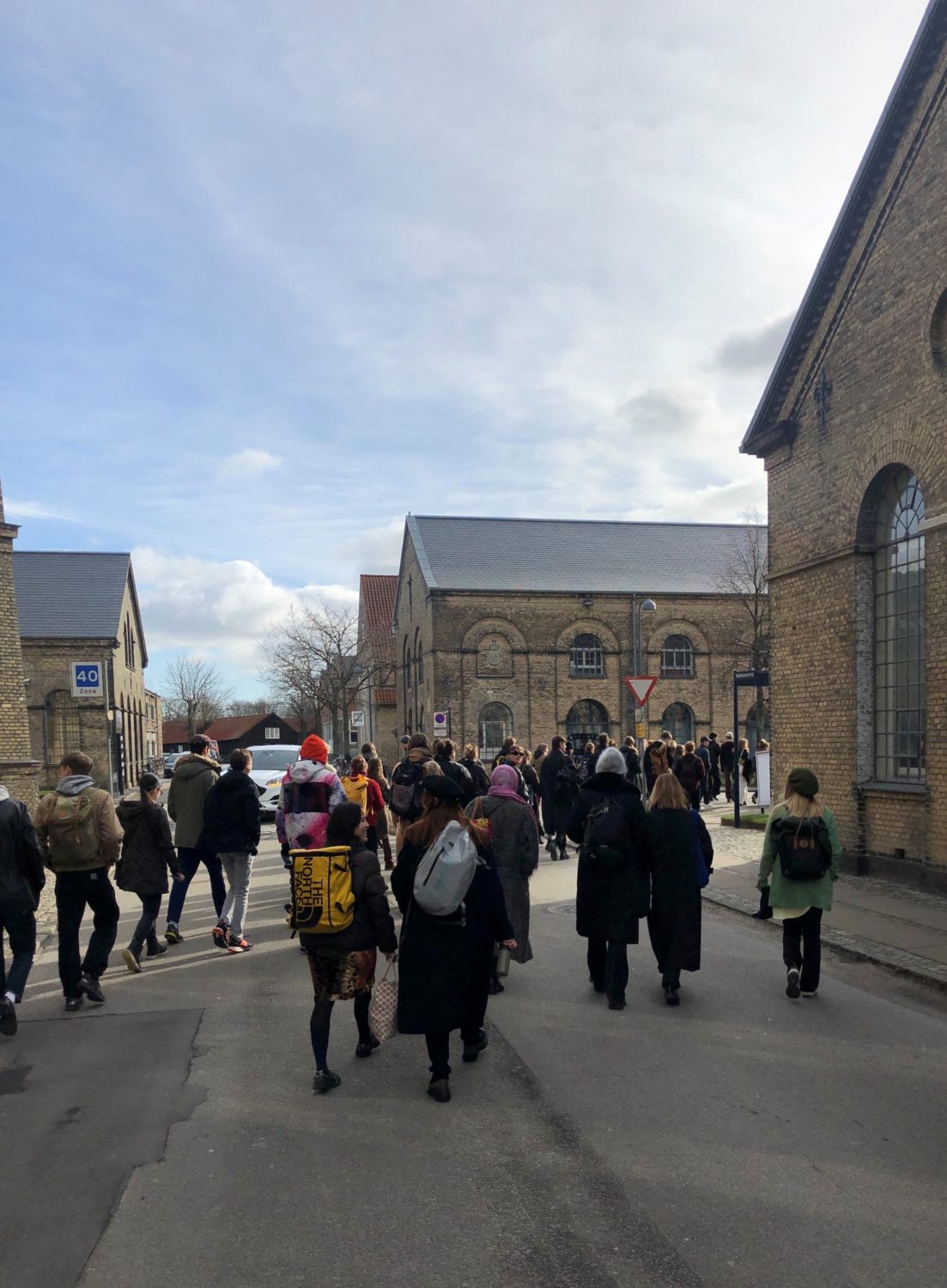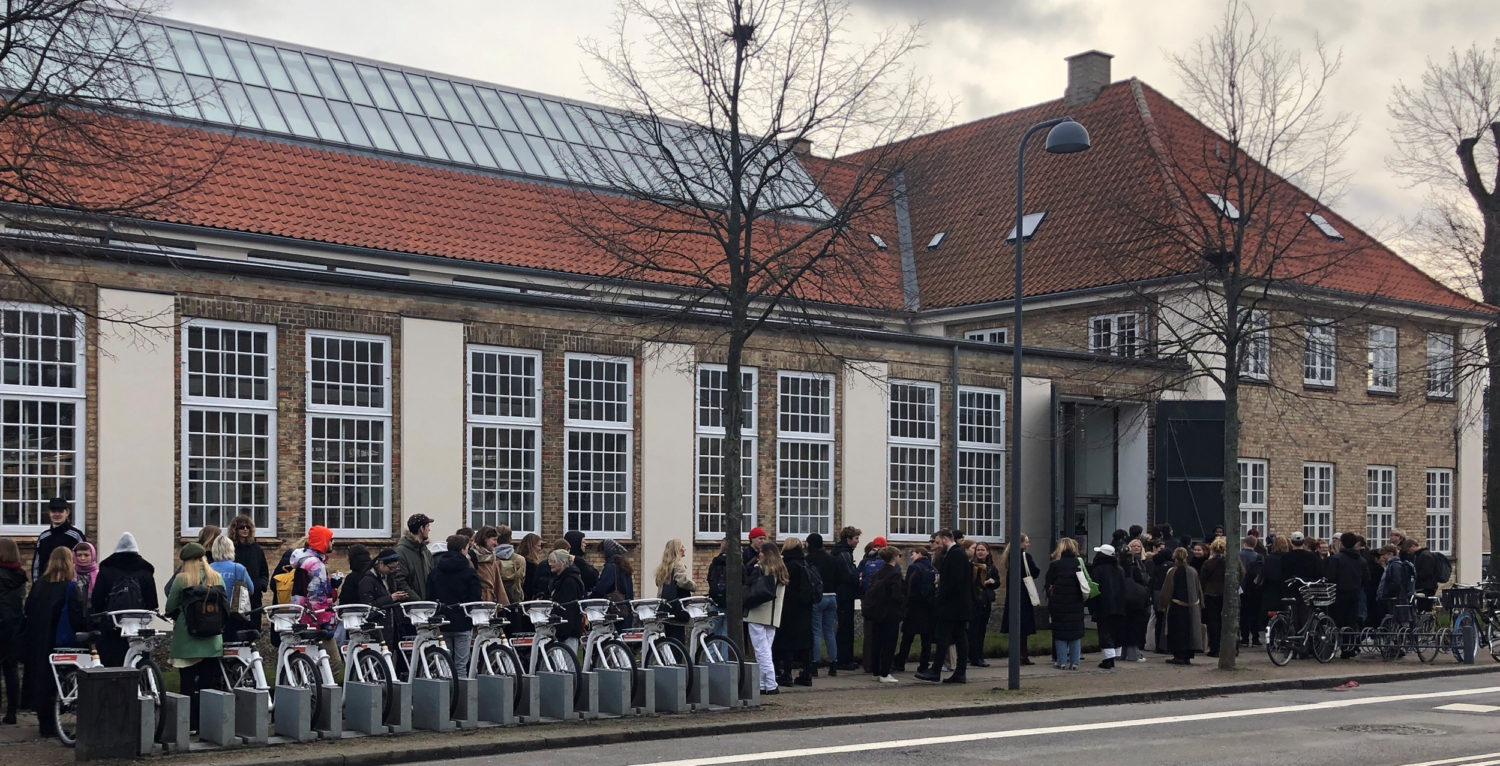When rebellions succeed, they transition into a prolonged political effort. Less romantic, more mundane. The students behind the rebellion in the design school at the Royal Danish Academy in Copenhagen this past winter are trying to keep up the pressure and are feeling less green – except where the climate is concerned: in that area they are green to the core.
It is Friday afternoon, and only a few students still remain in ‘the white building’ on the Royal Danish Academy campus at Holmen, where many of the design students have their workshops. The central role of the workshops was a topic of intense debate in the school of design at the beginning of 2022. ‘Student rebellion’ was the label the press applied to the criticism and protests from students who wanted to re-establish the core emphasis on practice and workshop activities after recent years’ growing emphasis on theory in the programme, which is now categorized as academic.
Sara Toftelund Sommer and Felix Sand Sørensen were among the students who spoke up back then. Since then, they have engaged in dialogue with the Academy’s leadership, in part by serving on the Study Committee. The press gave up its focus on the topic once the protest marches stopped and the real conversation about the future began. That does not mean that the ‘student rebellion’ died down, however. Instead, it is more accurate to say that it entered a new phase, just as the process did not begin with the protests in February. The situation had been building for a long time.
‘It began spontaneously. I wrote an email to some students from the year above who were working on their bachelor’s projects. The administration provided me with their email addresses, and when I asked whether they might be interested in joining [a complaint about conditions at the Academy], my invitation triggered an avalanche of dissatisfaction from them too. This made me realize the problem is probably bigger than I initially thought, and we began to compare notes,’ says Sara.
‘We didn’t know that other years and lines of study were struggling with the same concerns,’ Felix adds. ‘We agreed to meet during the lunch breaks to see how widespread the experience was. We began to have these discussions in early December 2021, and some of the participants then began to draft the letter that was published in February and which summarized our concerns.’
No room for experimentation
Once the students got together across years and lines of study, they discovered they had a lot in common, even though each line has its own unique challenges. The letter that was sent to the Academy’s leadership in February condensed the problems into two main issues: problems with workshop use and curriculum content, especially the emphasis on new topics, such as strategic design.
‘We have great workshop facilities, but we’re not always able to use them,’ Sara explains. ‘Even if the workshops stay open until 10 in the evening, many of the workshop staff who provide instruction in the use of the machines are only there part-time. So if I’m engaged in a process on Wednesday afternoon and need to work in the printing room, I won’t be able to get help until Monday. If I need to use a textile steamer on Friday in order to continue my process over the weekend, there is no assistance available. It is really hard to plan around that …’
Another issue is that the use of the workshops varies over the course of the semester, with demand peaking when everyone is working on their semester projects. Generally, the students’ focus on workshop facilities also reflects their perception of the workshops as the main setting for the development of their core professional competencies through material experiments.
‘It is during our studies that we’re able to engage in free processes – I’m not sure we’ll have that opportunity later, in our working lives. Here we have the freedom to experiment and make mistakes!’ Sara observes.
‘Our familiarity with experimentation is one of our main strengths on the labour market,’ says Felix. ‘The budget cuts reflect unemployment rates among the new graduates, but workshop experience is exactly what we need to be attractive on the future labour market – provided we have the opportunity to experiment and test our ideas. We hope to preserve that opportunity.’
They both point out that the school of design in Copenhagen has superior facilities compared to many schools of design around the world, where it is not uncommon for students to have to rely on workshops at private companies associated with the schools. At the school of design in Copenhagen, everything is on campus, which provides a unique possibility for developing a common campus culture where the students live and breathe in the workshops. That is one of the key features attracting students to the programmes, which is why it feels like a breach of contract between the students and the Academy when the programme, in practice, fails to deliver on this promise.
The T-shaped designer
The same sense of a breach of contract also underlies the students’ criticism of the curriculum. Both Sara and Felix underscore that this is not a criticism of the growing emphasis on academic aspects in design studies. Rather, the problem has to do with the specific modules that have been added in recent years and which take time away from hands-on work. The main target of this criticism is the strategic design module during the second year. This is primarily a theoretical course that teachers the students about the potential roles of designers as facilitators in interdisciplinary projects. The school of design thus operates with the concept of the ‘T-shaped designer’ – a designer with a profile that is both specialized and broad and who is thus capable of collaborating with other professionals, including engineers, anthropologists or technicians.
‘That is certainly relevant for the profession, but it’s not an area you can master after just two modules, which account for about 10 per cent of the BA programme,’ says Felix. ‘Strategic design becomes a mini-competence that we don’t have time to develop properly. It ought to be a study line in its own right. We enrolled in the classic design lines and don’t feel that this area contributes to our core professional competencies.’
‘After all, our core professional competencies are what make us relevant to other professions to engage with. I can easily see a role for strategic designers as facilitators of those sorts of collaborative projects but only if there are also designers who specialize in working with materials and form.’
Thus, a slightly unkind view of the strategic design module might be that it was added to the BA programme in order to please prospective employers. It promotes the notion of agile, adaptive designers who do not lose themselves in nerdy experiments and who excel at describing what they do in catchy phrases.
Felix agrees. ‘To some extent, the programmes produces generalists who can do a little bit of everything. Some are also putting pressure on the leadership to ensure funding for the programme. This whole process has taught us that the system is outrageously difficult and outrageously unfair. Everything is about money. I now have greater empathy with the leadership. While others are applying pressure from above, we are applying pressure from below,’ Sara comments.
‘In the beginning of this rebellion, we might have been a little green, but fortunately, that has changed. We know that it’s all about money and about employment rates. But will we have an easier time finding work as facilitators than if we have specific skills? I don’t see any evidence of that,’ says Felix.
The green transition is always in the back of our minds
The leadership underscores that the climate crisis and the green transition are going to require broad partnerships involving many different professions and that designers need to adapt to these new roles.
‘That is a valid point,’ says Felix. ‘But in order to contribute to the green transition, we are going to need in-depth knowledge and the ability to experiment and design with materials. Inherently, the purpose of the school is to bring even more objects into the world, so how can we make a difference and create something that is durable in a material as well as an aesthetic sense? If we’re all going to be strategists, 20 years from now, there won’t be anyone left who masters the craft aspects and who insists that if we’re going to make new products, they have to be durable and high quality. For example, it might make sense to design new furniture if the new products are easy to repair.’
‘We are no longer interested in growth, we want to make quality stuff. Climate guilt is a big factor for us. How can I work with industry without becoming like the adults and simply add another problem to the existing ones? In our generation, the green transition is always in the back of our minds – no one needs to force us to think that way, it comes naturally,’ says Sara.
‘The school’s vision of the T-shaped designer accommodates the market rather than the green transition,’ says Felix. ‘In practice, the programme does not have a very strong focus on the green transition. In many cases, people find a way to label their project as “green” in the 11th hour, when, really, it ought to be the key premise.’
It is apparent that while the students have long since embraced the green transition, the political level is still lagging, and this includes the school’s leadership. And while the dialogue and relationship between the students and the school’s leadership have been good in the wake of the student rebellion, which also resulted in minor changes to the study programme, there is no compromise when it comes to the climate issue. In this area, the students are going to maintain constant pressure. Generally, the student rebellion is far from over, it has simply moved into a new phase, from protest to political effort. While the students were once outside the political processes, they are now a part of them.
‘The students are once again engaging in the political processes. We have learned a lot, but it’s a really lengthy process, and that has taken some of the passion out of the original protest,’ says Felix.
‘It’s difficult to include all the students in the political processes in the various councils and committees, and it’s difficult to keep everyone informed in order to maintain the passion,’ says Sara. The students have not received any training in the school’s political traditions or the cooperation between students and leadership. Everyone has to learn as they go.
‘It’s a good thing we didn’t stage a blockade back then, as many suggested,’ says Felix. ‘I think we should strive to change things from the inside. Hopefully, we can build a new culture around that.’
Theme: Student rebellion
Formkraft gives the floor to both students and institutions and examines contemporary educational opportunities for craft artists and designers.
Follow along from November 2022 – January 2023 when Formkraft takes stock of the design education in Denmark.



